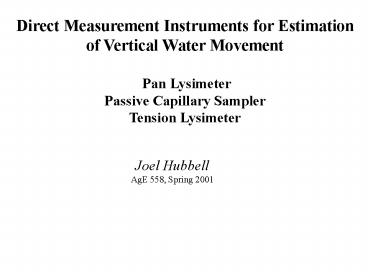Direct Measurement Instruments for Estimation - PowerPoint PPT Presentation
1 / 21
Title:
Direct Measurement Instruments for Estimation
Description:
Tension Lysimeter. Theory of operation. Construction, installation and operation ... Pan Lysimeter. Intersect flow and route to sampling location. Impermeable ... – PowerPoint PPT presentation
Number of Views:93
Avg rating:3.0/5.0
Title: Direct Measurement Instruments for Estimation
1
Direct Measurement Instruments for Estimation of
Vertical Water Movement Pan Lysimeter Passive
Capillary Sampler Tension Lysimeter
Joel Hubbell AgE 558, Spring 2001
2
State Variables for Characterizing the Vadose Zone
? Soil Water Potential Hydraulic
gradient ? Water Content Mass of water-changes
in time and space ? Flux Rate ? Concentration of
Solutes
3
Pan LysimeterPassive Capillary Sampler
(PCAPS)Tension Lysimeter
? Theory of operation ? Construction,
installation and operation ? Advantages and
limitations ? Comparison of devices
4
Pan Lysimeter
Intersect flow and route to sampling
location Impermeable layer beneath
site Numerous configurations Pan, plastic,
glass block, funnel
5
Pan Lysimeter
6
Pan Lysimeter
7
Pan Lysimeter
8
Pan Lysimeter
9
Pan Lysimeters
Advantages Simple design Lower costs
Available materials Limitations Divergent
flow (under sampling) Collect 0 to 36-45 of
flow (optimum) Difficult to design to predict
flux Samples macropores-wet conditions
10
Passive Capillary Sampler
Intercepts flow Collects with a constant
pressure Wick fluid with fiberglass rope
11
PCAPS
12
Passive Capillary Sampler
13
Passive Capillary Sampler
Assets Passive design Macro/micro pore
flow Best in sands More representative
flux 103, 80, 64 of WB Well published-12
articles Limitations Soil water potential
lt-150 cm wet Clay and silts lower
recoveries Design/materials more
complex Installation more complex-undisturbed
14
Tension Lysimeter
15
Tension Lysimeter
16
Tension Lysimeter
Advantages Able to sample tensiometeric
range Good for sands, silts and clays Matches
SWP in device with existing conditions Could be
automated Should produce best estimate of
flux Limitations Complex design Sophisticated
instrument High cost of operation Few papers
17
Comparison of Instruments
Flux representiveness Pan/Gravity Lysimeter
PCAPS Tension Lysimeter Overall Low
Medium-High
High For Low water potential(dry)
Low
Low High High water potential
(wet) Best Good
Good Chemical representiveness of
sample Highest Good Fair
18
Comparison of Instruments
Pan/Gravity Lysimeter PCAPS
Tension Lysimeter Primary pore size
sampled Macro pore Macro pore
Macro and micro Water
Pressure range of operation 0-unk (Wet
range only) 0 to about 80 cm 0 to
-700cm (up to 150
cm) Vary tension range for sampling?
(flexibility) No Limited 0
to -80 cm Yes, 0 to 700 cm Best to
Sample Sand Sand Clay-course sand
19
Comparison of Instruments
Pan/Gravity Lysimeter PCAPS
Tension Lysimeter
Cost to install and construct tool Medium-high
Medium-high
High Complexity of design Low
High
Very high
Ease of operation Easy
Medium Difficult
Mode of
operation Passive Passive
Active Cost of operation Low
Low
High
20
Conclusions
Pan Lysimeter Least accuracy/complexity PCAPS Mo
re accurate/complex Tension Lysimeter Best/most
complex ? Problem is standard for
comparison Also impedance match ? Spatial
variability in recharge Preferential
flow-Finger, funnel flow, fast flow paths
21
Caution
Although the technique (flux meters) has worked
well for those researchers that have perfected
it subtleties, it does not appear to be
pragmatic on a large-area basis and should be
used only for very localized and specialized
studies. (Wagenet, MOSA 1986)































